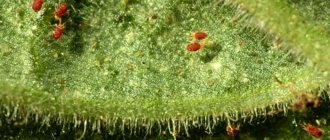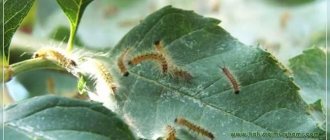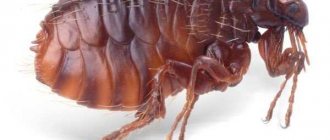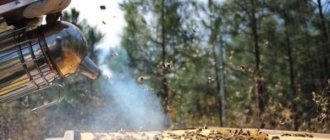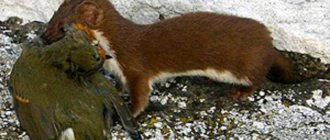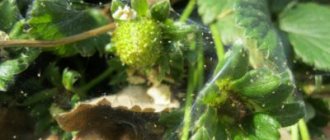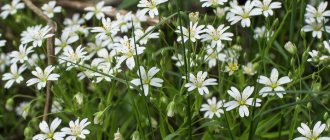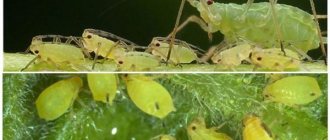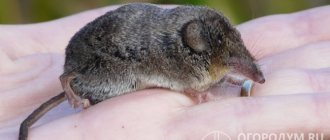What do mites look like on orchids?
Small pests with an elliptical, oval-shaped body, with 4 pairs of legs. Length – 0.1-1.1 mm. Color depends on the type (whitish, black, brick, yellowish). Inconspicuous, they prefer to settle on the lower part of leaf blades, laying eggs along the way. If you do not pay attention to the flower, the population grows to catastrophic proportions.
External signs of infection:
- small depressed gray blotches on the green part of the leaves;
- deformation, drying of the plates along the edges, characteristic silvery coating;
- thin-leaved - curl into a tube, turn yellow, fall off;
- rotten areas at the base of the plant;
- unusually short peduncles, brown spots on deformed flowers;
- web.
Which parts of the flower are affected?
Depending on the family, mites settle in the substrate, on leaf blades, or at the growing point. Active life activity harms green mass, buds, peduncles, flowers, and roots.
Types of damage:
- in places of bites, the leaves lose juice along with chlorophyll cells. The damage gradually spreads to the entire flower, the plates acquire a marbled coating, turn brown, and finally dry out;
- living in the substrate, damage the root system. Feeding on plant tissue, large colonies turn roots into dust.
Peculiarity! A pest is a carrier of bacteria, fungi, and viruses. Along with damage from their vital activity, infectious lesions develop. The first sign is wet spots on the foliage.
Why is Phalaenopsis dangerous?
Ticks love the fleshy leaves of Phalaenopsis. They bite the juicy flesh, injecting a toxic substance into the cells.
Then the following happens:
- toxins dissolve the membranes, the orchid secretes juice;
- The mite sucks out the juice and air gets inside the cells. The green mass turns white;
- Over time, the leaves turn yellow and fall off, and the Phalaenopsis dies.
Peculiarity! If a flower is attacked by an oribatid mite, the deformation begins from the topmost leaf. The cover becomes thinner, corrugated edges appear. On adult specimens, the edges of the flowers are eaten away and dark spots form on them. The damaged plant dies.
Signs of defeat
The mite feeds by sucking juices from plant cells, which first leads to the appearance of small spots, and then to depigmentation of the entire leaf. It is easy to determine whether a plant is affected by this pest - just take a close look at the leaves and flowers, paying attention to:
- the presence of a small cobweb on the back of the leaf, as well as on the flowers;
- brownish dots located all over the surface of the leaves, and the tips are curled and withered;
- small dots (these are the mites themselves) moving along the surface of the plant or along the web.
Description of types of ticks with photos
The pest belongs to the class of arachnids and has more than a hundred families and 50 thousand species. Only some of them attack indoor plants.
Arachnoid
Changes color depending on the food consumed. As a rule, it takes on a red or green color.
Description:
- abdomen oval, 0.3-0.5 mm;
- loves warmth and dryness. Young individuals develop poorly in high humidity;
- lives in a thin web, multiplies quickly, giving dozens of new generations;
- the moment of maturity occurs 10-20 days after laying eggs. Larvae have 3 pairs of legs;
- life cycle – no more than 4-5 weeks.
White
A representative of the group of spider mites. The body is oval, elongated, sharply tapering towards the posterior end. Size – 0.25-0.43 mm. Lays greenish glassy, spherical eggs. It feeds on the underside of leaves; in places where it is pricked, the tissues become discolored and die.
Red
Very small, about 0.25 mm, inactive, oval, with a red belly, head, and paws.
There are two types:
- Tenuipaltis pacificus – orchidaceous;
- Brevipalpus obovatus – greenhouse mite.
It does not weave a web, so it is difficult to notice. The mite slowly spreads throughout the flower, so visible lesions are a sign of a huge population. Lives on the inside of the plates. Calmly survives high humidity.
Armored
The Oribatidae group of ticks is diverse and contains more than 6 thousand representatives. House plants are attacked by small black insects, 0.2-1.4 mm in size. They live in the substrate - often based on bark, feeding on plant debris and moss. Less common in blocks. They prefer vanda, phalaenopsis, paphiopedilum. Harm comes from catastrophically large colonies.
Bulbous
A large insect with a thickened oval body and two pairs of legs. The color is whitish, cloudy, glassy. Body length – up to 1.1 mm and more. During its life, it lays white, oval eggs. Prefers overfed, abundantly moistened substrate. Turns roots into dust, causing the death of the orchid.
Root
Broadly oval, light yellow, with glossy, smooth skin. The legs are short, thick, with large spines. Length – 0.78-1 mm. Females lay oval white eggs. It feeds on plant tissues of the root system. Very moisture-loving. It quickly thins the roots, turning them into dust. Leaves and flower stalks are damaged. Carrier of fungi and bacteria. If measures are not taken, the orchid will die.
Ways to fight
What to do if you find a characteristic cobweb on your orchids? The most effective measure is considered to be treating plants with modern chemicals. When the degree of infection is still low, you can try proven folk methods in the fight against ticks. But first you should wash the surface of the foliage with water and laundry soap or dishwashing detergent. Based on 1 tbsp. l. drug per 1 liter of warm water.
Experienced flower growers sometimes create a greenhouse effect to eliminate pests: the flower is watered and placed in a transparent bag for 3 days. This way it is possible to increase the level of humidity and kill insects. But there is a risk of harming the health of the orchids themselves. Therefore, next we will look at the most popular folk and chemical remedies that help cope with white plaque and insects.
Chemicals
Experts recommend alternating store-bought products. This measure is necessary because in the case of frequent use of the same drug, pests develop strong immunity to this insecticide. The most popular and effective products include “Apollo”, “Neoron”, “Tiofos”, “Aktellik”, “Fitoverm”. For alternation, it is recommended to use the drugs “Vertimek”, “Akarin”, “Sunmite”, “Omite”, “Borneo”, “Oberon”, “Kleschevit”, “Dursban”.
The Apollo remedy is effective when the development of the parasite is still at the larval stage. The use of the drug will only make it possible to sterilize adult individuals, but not to physically destroy them. How to fight? It is recommended to dilute 2 ml of the drug in 5 liters of water and treat your favorite plant twice.
Actellik is an organophosphate preparation based on pirimiphos-methyl. It is highly toxic, which excludes the possibility of use in enclosed spaces. Before use, the contents of 1 ampoule should be diluted in 1 liter of water. A strong effect is achieved by treating the crop twice with a mandatory break of 1 week. The drug has a protective effect against the reappearance of insects and the formation of cobwebs within 1–2 weeks.
If you find white spots and other signs of damage on your flower, you can treat it with Fitoverm. This biological preparation is created based on the results of the vital activity of soil inhabitants. For spraying, which needs to be carried out 4 times with an interval of 1 week, you should dilute 2.5 ml of the product in 1.25 liters of water.
Any chemical must be used to treat both the foliage (especially carefully on the back side) and the soil
It is also important to take into account the period of the life cycle when scheduled disinfection will be carried out.
Folk remedies
Folk remedies can also help with mites, cobwebs left on the surface of foliage and other unpleasant signs of infection. Two of them can be called popular - a decoction of cyclamen tubers and treatment with medical alcohol.
To prepare the decoction, the tubers are divided into parts and boiled for about 40 minutes. Next, leave for a day and filter. Spraying is carried out a couple of times with a break of 5 days.
What to do?
The fight against spider pests begins with thoroughly washing the outer part of the orchid. The plant is carefully and carefully wiped. Take a solution based on laundry soap or dishwashing detergent. Do not allow liquid to get on the roots. The substrate will move towards the alkaline side and damage the flower.
Armored ones live in the substrate, here the procedure is different:
- Remove the flower from the pot.
- If possible, completely remove old bark.
- Soak the root in warm water for 30-40 minutes. The tick will get into the air capsule and float up over time. Periodically stir the plant in the water to shake off the balls.
- Mites have appeared on the water, remove the flower and drain the liquid.
- Repeat 2-3 times. Make sure all bugs are washed away.
- Plant in new substrate.
Important! Remove damaged peduncles and leaves. Disinfect the cut areas with cinnamon or activated carbon. Treat with traditional methods or an insecticide.
How to fight with folk remedies?
If your orchid is infested with spider mites, hide it in a sealed plastic bag. Flush well first. Leave for 3-4 days in a shaded area, otherwise the flower may wither. A microclimate with high humidity is formed inside. Thus, the bulk of the population will die before the chemicals are applied.
Recipes:
- cyclamen - use a decoction of tubers. Divide into parts, boil in boiling water for 40 minutes. Cool, leave to infuse for 24 hours, filter. Treat the leaves with a spray bottle and repeat after 5 days;
- rubbing alcohol – works on varieties with tough leaves, such as cattleya. Test on a small area. Wipe the plates with a slightly moistened cotton pad. Make sure that the liquid is applied in a thin layer. This way it will evaporate quickly and will not cause burns.
How to get rid of it with drugs?
A group of drugs aimed at eliminating ticks is called acaricides. Read the instructions to properly dilute the solution. Wear gloves.
Important! You cannot completely rely on the effectiveness of chemicals, since ticks quickly develop immunity. The solution is to purchase two concentrates with different active ingredients.
Types of acaricides:
- contact - pyrethroids penetrate the skin of the pest;
- intestinal – enter through the mouth;
- systemic - absorbed by plates, orchid roots. The juice becomes poisonous.
Spraying is carried out during the growing season. Use ready-made solutions in the form of sprays. Treat all green mass and soil. Spray twice, repeating the procedure after 14 days.
If you choose concentrate:
- dilute the drug according to the instructions in a bowl of water;
- cover the substrate with film;
- dip the green mass of the flower into the solution, wetting each part - growing points, rosettes, axils;
- carry out additional treatment with a fungicide if the orchid has become infected with fungus.
Table No. 1. Acaricides for orchids
| Name | Active substance | Processing type | Working solution | Efficiency |
| Vertimek | Abamectin | Spraying, the plant is placed in a bag, removed after a day | 18 g/l | +++ |
| NimAtzal 1% | Azadirakhtin | Wipe both sides of the sheets with the working solution. 1-3 treatments are required with an interval of 5-7 days | 7.5 ml/1.5 l | ++ |
| Apollo | Clofentesine | Spraying green mass | 2 ml/5l | +++ |
| BI-58 | Dimethoate | Spraying | 4g/l | ++ |
| Dimethane-SK | Phenazakhin | Spraying | 2g/l | +++ |
| Masai | Tebufenpyrad | Soaking green mass | 5 g/l | ++ |
Prevention of infection
Spider mites infect orchids quite often. For planting, you need to use only a tested and disinfected substrate. When purchasing new plants, they must be quarantined for 2 weeks in a separate room.
It is important to do:
- regular inspection of the flower;
- wiping the stems and leaves with a disinfectant;
- watering, for which use warm water, which helps wash off the parasite larvae and adults;
- regular inspection of the soil to prevent waterlogging or drying out;
- timely removal of water droplets that remain inside the inflorescences after spraying;
- humidification of the room, since dry air promotes the active reproduction of pests;
- regular spraying.
You may be interested in:
What to do if all the leaves of an orchid have fallen off Amazing orchid flowers decorate interiors with their delicacy and variety of color combinations. There are more than 30…Read more…
Spider mites on an orchid are a serious problem, and if it occurs, you need to immediately begin fighting it to prevent the death of the flower. Many techniques have been developed to help in this situation, but the choice of method must be done very carefully so as not to aggravate the condition of the plant.
Preventive measures
Newly purchased orchids need inspection. Arm yourself with a magnifying glass and check them for ticks and eggs. Wipe the leaves with a damp cloth - this will make it easier to detect small punctures.
Prevention:
- Give the plant a hot shower periodically. This will partially kill the eggs and help you quickly recognize the web, if there is one. The water temperature should be such that the delicate skin on the bend of the arm can withstand it.
- Treat all plants that were in the same room as the infected orchid. Wash the window sills and shelves on which the pots stand. Scald the containers with boiling water.
- Provide the correct microclimate, do not allow waterlogging or excess substrate.
- Remove old leaves in a timely manner and inspect the flower for damage.
Rate this post
Reasons for appearance
Infection of orchids by mites occurs through the air. Strong winds can carry the larvae of these creatures for many kilometers. In hot, windy weather, the most fertile time comes for ticks to “travel” through nearby surroundings. During the incubation period, humidity is also important - if it is 28-42%, then the parasite will multiply rapidly. As humidity decreases, the development of spider mites slows down.
Spider mites appear on the orchid when there is minimal humidity in the air, this is what provokes the active development of the pest. Mites can completely destroy many house plants in a few days or transform them beyond recognition.
To effectively stop the threat, you need to understand why the parasite appeared. Often, a similar phenomenon occurs when farmers buy seedlings in a store or exchange young plants with each other. Knowing the cause of the orchid disease, it will be easier to eliminate its consequences.

